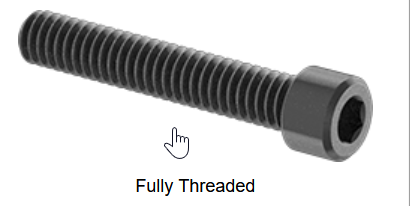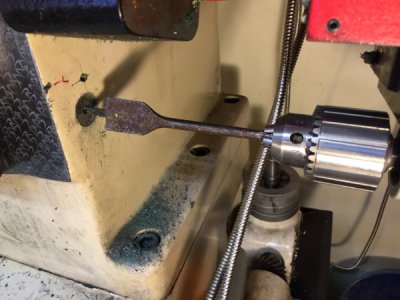-
Welcome back Guest! Did you know you can mentor other members here at H-M? If not, please check out our Relaunch of Hobby Machinist Mentoring Program!
You are using an out of date browser. It may not display this or other websites correctly.
You should upgrade or use an alternative browser.
You should upgrade or use an alternative browser.
"Best" way to drill and coutnerbore for a 1/2-20 bolt?
- Thread starter LVLAaron
- Start date
- Joined
- Feb 21, 2022
- Messages
- 772
Lost in translation, in the uk, cap screw usually refers to socket head cap screws only. Hexagon head screws and bolts are usually called hex head.
- Joined
- Feb 1, 2015
- Messages
- 9,631
From Machinery's Handbook, 25th ed., pp. 1417: "A bolt is an externally threaded fastener designed for insertion though holes on assembled and is normally intended to be tightened or released by torquing a nut. ..... A screw is an externally threaded fastener capable of being inserted into holes in assembled parts, of mating of mating with a preformed internal thread or forming its own thread and capable of being tightened or released by torquing the head."Cap screws usually have threads the entire length of the bolt. Bolts have threads on roughly 1/3 - 2/3 the bolt length
Both Fastenal and Grainger sell both hex head screws and hex head bolts in full or partial thread configurations. For some reason, McMaster Carr doesn't sell hex head bolts, only hex head cap screws in either full or partially threaded configuration They do sell carriage bolt which are fully threaded for the most part. Go figure.
- Joined
- Oct 4, 2020
- Messages
- 484
FYI... this is what I'm talking about 

And will be using this. https://www.mscdirect.com/product/details/43983675

And will be using this. https://www.mscdirect.com/product/details/43983675
- Joined
- Nov 17, 2017
- Messages
- 1,525
From Machinery's Handbook, 25th ed., pp. 1417: "A bolt is an externally threaded fastener designed for insertion though holes on assembled and is normally intended to be tightened or released by torquing a nut. ..... A screw is an externally threaded fastener capable of being inserted into holes in assembled parts, of mating of mating with a preformed internal thread or forming its own thread and capable of being tightened or released by torquing the head."
Both Fastenal and Grainger sell both hex head screws and hex head bolts in full or partial thread configurations. For some reason, McMaster Carr doesn't sell hex head bolts, only hex head cap screws in either full or partially threaded configuration They do sell carriage bolt which are fully threaded for the most part. Go figure.
If you torque it from the head its a screw
If you torque it from a nut it is a bolt
So, what is the design difference between a hex-head bolt and a hex head screw?
Is there some fillet that is on the screw and not the bolt? or vice versa ?
Is there some relief that is on the screw and not the bolt? or vice versa ?
Do you use a different washer on the screw or bolt.
Or is this something that has passed into history?
- Joined
- Feb 1, 2015
- Messages
- 9,631
I think your last option is most likely. The original meaning of "bolt" was a short arrow as in a crossbow bolt. It came to mean a short metal pin used to fasten objects together in the 1400's. Adding a head and threads was an obvious improvement.If you torque it from the head its a screw
If you torque it from a nut it is a bolt
So, what is the design difference between a hex-head bolt and a hex head screw?
Is there some fillet that is on the screw and not the bolt? or vice versa ?
Is there some relief that is on the screw and not the bolt? or vice versa ?
Do you use a different washer on the screw or bolt.
Or is this something that has passed into history?
Meanwhile, the screw traces its roots to antiquity. It was used in Roman times as a fastener. At some point around the eighteenth century, the two came together and the distinction fades. It is interesting that plow bolts and carriage bolts are still called bolts. They definitely fit the above description as the square shoulder under each prevent turning the head.
I don't know of any physical distinction between bolts and screws.
- Joined
- Feb 21, 2022
- Messages
- 772
The most common reference is that a screw is threaded to the head and a bolt has a plain portion, any other references have no practical use.If you torque it from the head its a screw
If you torque it from a nut it is a bolt
So, what is the design difference between a hex-head bolt and a hex head screw?
Is there some fillet that is on the screw and not the bolt? or vice versa ?
Is there some relief that is on the screw and not the bolt? or vice versa ?
Do you use a different washer on the screw or bolt.
Or is this something that has passed into history?
- Joined
- Feb 13, 2017
- Messages
- 2,138
Without going into technical definitions, as a rule screws and bolts are the same except: Screws, or machine screws are described as such when they are sized to machine screw dimensions, size 0 to 16, and have screwdriver fitted heads. Bolts are such for fractional sizes and using a wrench. There is a fuzzy area around the transition, my father used 1/8 inch 'stove' bolts that used a screwdriver. And I use machine screws, sized 0.047 or Nr 00, that have a hex head. Over time, I think the original definition has been lost. Bolts are called 'cap screws' by many, including myself. Socket head 'screws' have further muddied the water. I call 'em what I want to call 'em, and don't get hung up on technical names.
- Joined
- Feb 7, 2013
- Messages
- 2,490
My best way is to use an end mill after drilling the hole. I use one set up and have my DRO on so I mill in the right spot.
One person's best way is not necessarily another person's best way depending on what tools one has at hand. If someone
offered to give me a bunch of counter bores or a bunch of end mills, I would go for the end mills for sure.
One person's best way is not necessarily another person's best way depending on what tools one has at hand. If someone
offered to give me a bunch of counter bores or a bunch of end mills, I would go for the end mills for sure.
- Joined
- Oct 13, 2014
- Messages
- 6,882
I have successfully counterbored in cast iron with a spade bit (normally used for wood) while installing the DRO on my Mill. They were shallow cuts, but I felt I could have gone deeper if needed. The spade bit was still usable for wood afterwards.



